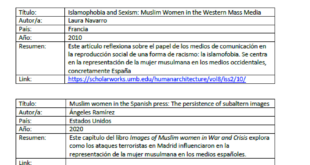LAURA MIJARES MOLINA, JOHANNA MARTINE LEMS, VIRTUDES TÉLLEZ DELGADO
Revista de Estudios Internacionales Mediterráneos, Núm. 24 (2018)
Resumen
El objetivo de este monográfico es ir más allá de los debates terminológicos sobre islamofobia, para centrar nuestra atención en las prácticas que causan y están implicadas en la construcción de sujetos subalternos musulmanes en el seno del Estado español. Con los seis artículos del monográfico se busca profundizar en la comprensión de las dinámicas y el alcance de los procesos de exclusión a través de los cuales las personas, y los grupos, (auto)identificados como musulmanes son estigmatizados y discriminados de un modo estructural, por medio de diferentes tipos de islamofobia institucionalizada.
Palabras clave: musulmanes/as, España, islamofobia, racismo anti-musulmán, racialización
Texto completo:
Referencias
AKHTAR, Rumana (2011): Islamophobia and its Effects on British South Asian Muslims post 9/11, PhD thesis, Manchester, UK, Manchester Metropolitan University.
https://e-space.mmu.ac.uk/576503/1/Akhtar%20(Rumana)%202011%20(MMU.pdf [accessed 8 June 2018].
ALLEN, Christopher (2004): “Justifying Islamophobia: A Post-9/11 Consideration of the European Union and British Contexts”, American Journal of Islamic Social Sciences, nº 21 (3), pp. 1-25.
COLE, Mike y MAISURIA, Alpesh (2007): “’Shut the f***up’, ‘you have no rights here’: Critical Race Theory and Racialisation in post-7/7 racist Britain”, Journal for Critical Education Policy Studies, nº 5 (1), pp. 94-120.
DE KONING, Martijn J. M. (2016): “’You Need to Present a Counter-Message’: The Racialisation of Dutch Muslims and Anti-Islamophobia Initiatives”, Journal of Muslims in Europe, vol. 5, nº 2, pp. 170-189. https://doi.org/10.1163/22117954-12341325.
ENAR, European Network Against Racism (2016): Forgotten Women. The impact of Islamophobia on Muslim women. Brussels: ENAR http://www.enar-eu.org/IMG/pdf/forgottenwomenpublication_lr_final_with_latest_corrections.pdf [accessed 30 March 2017].
EURISLAM (2013): Final Integrated Report. “Finding a place for Islam in Europe. Cultural interactions between Muslim immigrants and receiving societies”. http://www.eurislam.eu/var/EURISLAM_Final_Integrated_Research_Report_1.pdf [accessed 21 January 2015].
EUROPEAN ISLAMOPHOBIA REPORT (2016): http://www.islamophobiaeurope.com/reports/2016-reports/ [accessed 30 March 2017].
FASSIN, Didier (2011): “Racialization: How to Does Races with Bodies”, in MASCIA-LEES, Frances E. (ed.), A Companion to the Anthropology of the Body and Embodiment, Hoboken, Nueva Jersey, Wiley-Blackwell pp. 419-434. https://doi.org/10.1002/9781444340488.ch24.
FRASER, Nancy (2000): “Rethinking Recognition”, New Left Review, nº 3, pp. 107-120. https://newleftreview.org/II/3/nancy-fraser-rethinking-recognition [accessed 10 June 2018].
GARNER, Steve & SELOD, Saher (2015): “The Racialization of Muslims: Empirical Studies of Islamophobia”, Critical Sociology, 41 (1): 9 -19. https://doi.org/10.1177/0896920514531606.
GEISSER, Vincent (2003): La Nouvelle Islamophobie, Paris: La Découverte.
GÖLE, Nilufer (2015): Islam and secularity. Londres. Duke University Press.
https://doi.org/10.1215/9780822375135
HAMMER, Juliane (2013): “(Muslim) Women’s Bodies, Islamophobia and American Politics”, Bulletin for the Study of Religion, vol. 42, nº 1, pp. 29-36. http://dx.doi.org/10.1558/bsor.v42i1.29.
KHIABANI, Golam y WILLIAMSON, Milly (2008): “Veiled bodies-naked racism: culture, politics and race in the Sun”, Race and Class, vol. 50 (2), pp. 69-88. http://dx.doi.org/10.1177/0306396808096394.
KUNDNANI, Arun (2016): Islamophobia: lay ideology of US-led empire, http://www.kundnani.org/draft-paper-on-islamophobia-as-lay-ideology-of-us-led-empire/ [Accessed 25 September 2016].
LÓPEZ BARGADOS, Alberto & Ángeles RAMÍREZ FERNÁNDEZ (2015): “Un decálogo a contracorriente sobre la islamofobia”, Viento Sur, 138: 19-26.
MASSOUMI, Narzanin, MILLS, Tom & MILLER, David (2017): What is Islamophobia? Racism, Social Movement and the State, Chicago, The University of Chicago Press. https://doi.org/10.2307/j.ctt1rfsndp.
MEER, Nasar (2013): “Racialization and Religion: Race, Culture and DIfference in the Study of Antisemitism and Islamophobia”, Ethnic and Racial Studies, vol. 36 (3), pp. 385-398. https://doi.org/10.1080/01419870.2013.734392.
MEER, Nasar y MODOOD, Tariq (2009): “Refutations of racism in the ‘Muslim Question’”, Patterns of Prejudice, nº 43 (3-4), pp. 335-354. https://doi.org/10.1080/00313220903109250.
MIJARES, Laura (2014): “El efecto Persépolis: procesos de domesticación y marginación de alumnas musulmanas en los centros educativos”, in RAMÍREZ, Ángeles (coord.): La alteridad imaginada. El pánico moral y la construcción de lo musulmán en España y Francia, Barcelona, Bellaterra, pp. 189-217.
MIJARES, Laura & Ángeles RAMÍREZ (2008): “Mujeres, pañuelo e islamofobia: un estado de la cuestión”, Anales de Historia Contemporánea, 2, pp. 121-135.
MODOOD, Tariq (2005): Multicultural politics: racism, ethnicity and Muslims in Britain, Edinburgh, Edinburgh University Press.
MOOSAVI, Leon (2015): “The Racialization of Muslim Converts in Britain and Their Experiences of Islamophobia”, Critical Sociology, nº 41 (1), pp. 41-56. https://doi.org/10.1177/0896920513504601.
___ (2013): “Islamophobia in the representations of Islam and Muslims by the British government between 2001 and 2007”, Turkish Journal of Sociology, 2013/2, 3/27, 2013/2, pp. 333-368.
NABI, Shaida Raffat (2011): How is Islamophobia Institutionalised? Racialised Governmentality and the Case of Muslim Students in British Universities. PhD thesis, Manchester, UK, The University of Manchester. https://www.escholar.manchester.ac.uk/api/datastream?publicationPid=uk-ac-man-scw:124257&datastreamId=FULL-TEXT.PDF [accessed 8 June 2018].
PETER, Frank (2013): “Visual Government and Islamophobia”, in PETER, Frank, DORNHOF, Sarah & ARIGITA, Elena (eds.), Islam and the Politics of Culture in Europe. Memory, Aesthetics, Art, Bielefeld, Transcript. https://doi.org/10.14361/transcript.9783839421765.93.
PLATAFORMA CIUDADANA CONTRA LA ISLAMOFOBIA (2017): Informe PCCI sobre la islamofobia en España 2016, http://plataformaciudadanacontralaislamofobia.org/wp-content/uploads/2017/04/Informe-sobre-la-islamofobia-en-Espa%C3%B1a-2016.pdf [accessed 21 June 2016]
PUAR, Jasbir (2007): Terrorist Assemblages: Homonationalism in Queer Time, Durham, Duke University Press.
RAMÍREZ, Ángeles (ed.) (2011): La trampa del velo. El debate sobre el uso del pañuelo musulmán, Madrid, La Catarata.
___ (2014): La alteridad imaginada. El pánico moral y la construcción de lo musulmán en España y Francia, Barcelona, Bellaterra.
___ (2016), “La construcción del “problema musulmán”: radicalización, islam y pobreza”, Viento Sur, 144, pp. 21-30.
RUIZ -BEJARANO, Barbara (2017): “Islamophobia as a Deterrent to Halal Global Trade”, Islamophobia Studies Journal, vol. 4, nº 1, pp. 129-146. https://doi.org/10.13169/islastudj.4.1.0129.
RUNNYMEDE TRUST (1997): Islamophobia: A challenge for us all, London, Runnymede Trust, https://www.runnymedetrust.org/companies/17/74/Islamophobia-A-Challenge-for-Us-All.html [accessed 10 June 2018].
___ (2017): Islamophobia: Still a challenge for us, London, Runnymede Trust, https://www.runnymedetrust.org/uploads/Islamophobia%20Report%202018%20FINAL.pdf [accessed 10 June 2018].
SAYYID, Salman (2014): “A Measure of Islamophobia”, Islamophobia Studies Journal, nº 2(1), pp. 10-25. https://doi.org/10.13169/islastudj.2.1.0010.
SCOTT, Joan W. (2010): The Politics of the Veil, Princeton, Princeton University Press.
SHEEHI, Stephen (2011): Islamophobia. The ideological campaign against Muslims, Atlanta, Clarity.
TUFAIL, Waqas y POYNTING, Scott (2013): “A Common ‘Outlawness’: Criminalisation of Muslim Minorities in the UK and Australia”, International Journal for Crime, Justice and Social Democracy, nº 2 (3), pp. 43-54. https://doi.org/10.5204/ijcjsd.v2i3.125.
ZINE, Jasmine (2006): “Unveiled Sentiments: Gendered Islamophobia and Experiences of Veiling among Muslim Girls in a Canadian Islamic School”, Equity and Excellence in Education, Special Issue: Ethno-Religious Oppression in Schools, vol. 39 (3), pp. 239-252. https://doi.org/10.1080/10665680600788503.
 Observatorio Islamofobia Por un periodismo inclusivo frente a la islamofobia
Observatorio Islamofobia Por un periodismo inclusivo frente a la islamofobia



